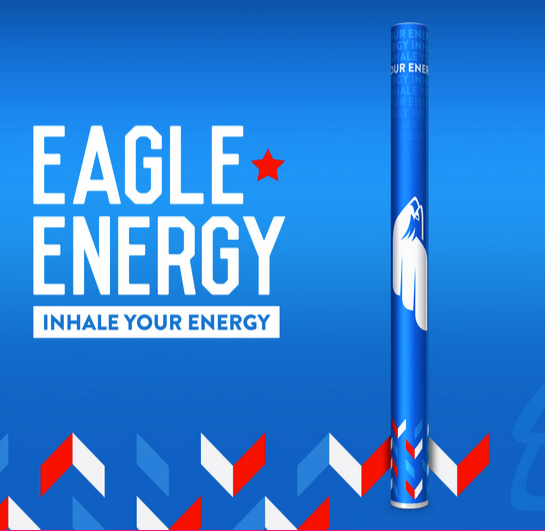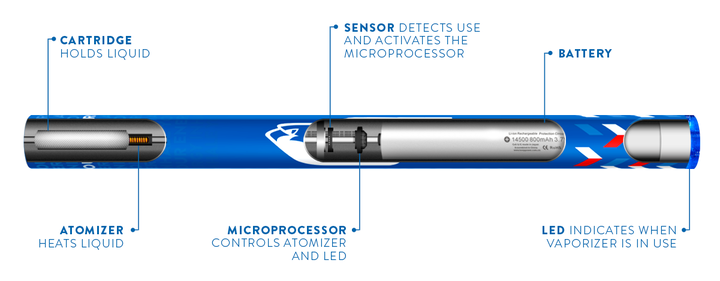
Why sip on a cup of coffee when you can literally inhale your daily dose of caffeine?
Vancouver-based Eagle Energy Vapor is one of several companies currently selling a caffeine vaporizer. These things work pretty much like e-cigarettes, but instead of delivering a hit of nicotine to your system, they deliver a caffeine buzz.
A bunch of intrepid reporters and editors at The Huffington Post's New York City office decided to test out Eagle Energy's disposable vape pens -- for science, and because most of us are hopeless caffeine addicts who leapt at the chance for an easy fix. Here's what we learned.
Eagle Energy's gizmos cost $9 apiece, or $75 for a pack of 10. The company started selling its caffeine-in-a-stick in April at select gas stations, liquor stores and tobacco shops across North America. It's also crowdfunding on Indiegogo to push out a line of three-packs.
Each five-inch stick is about as thin as a pencil. The inside contains a rechargeable lithium battery, sensors, liquid caffeine and an LED light that glows blue to indicate when the vaporizer is being puffed.

Its 3-milliliter liquid cartridge houses taurine, ginseng, Vitamin C and flavoring. Each cartridge is good for about 500 puffs, Matt Lang, Eagle Energy Vapor's marketing director, told HuffPost. However, he added that the amount of caffeine in one puff will be different for everyone.
"We recommend 10-20 puffs depending on each person's sensitivity to caffeine," Lang said, estimating that this is about equal to the roughly 95 - 200 milligrams of caffeine found in a single serving of black coffee.
The main difference between inhaling and drinking caffeine products is the delivery method, Lang noted. "Because you inhale Eagle Energy vs. ingest it, it bypasses the digestive system, giving it a more direct route to the bloodstream," he said. "This gives a much more immediate effect, and also a much more controllable experience for the user. You can stop as soon as you feel more alert as opposed to drinking an energy drink and waiting for it to kick in."
The company also prides its product on being free of nicotine and sugar, and claims that these qualities could prevent users from feeling a crash when the product begins to wear off.
While a few HuffPost team members experienced energy crashes a few hours after puffing on the vaporizer, all of us noticed the effects of inhaling the caffeine almost immediately.
These are a few of our reactions:
- "Oh my God, my heart is racing so fast. Am I going to die?" Sports Editor Maxwell Strachan wrote on Slack, four minutes after taking his first puff. He later added, "If I die I'm going to die smoking vape pen because it tastes delicious." He was seen puffing on the stick five hours later.
- "I don't feel exhausted anymore," said Business Editor Catharine Smith, after about 10 puffs. "It feels like having a cup of coffee, but too quickly."
- "I love this thing! I feel so good," wrote Community Manager Joey Mejias after continuously puffing on his vaporizer for 10 minutes. He contributed to Eagle Energy's crowdfunding campaign after 15 minutes of further research into the product, and finished an entire vaporizer over four days.
- "If you blow it out your nose, it tastes just like Red Bull," Associated Sports Editor Justin Block mused (a little too) happily.
- I'm pretty caffeine-sensitive -- I take about two cups of coffee a day -- and my heart started beating faster than normal for about two hours after inhaling five to six puffs. I even experienced some heartburn and had difficulty concentrating on tasks, but I did type very quickly.
- "The Eagle Energy has successfully replaced my morning coffee and is definitely better for focusing," wrote Multimedia Fellow Jake Reeves. "Downside, it feels like I'm smoking at my desk, which is definitely considered 'rude' in the office space."
- Impact and Innovations Deputy Managing Editor Alexis Kleinman posted this tweet approximately 15 minutes after her first puff*:
*She experienced a caffeine crash about two hours later.
The vaporizer itself has not been FDA tested or certified, Lang confirmed, but all of its ingredients are FDA approved. The company has also set up clinical trials in Northridge, California, to "further explore the inhalation of organic botanicals, including guarana," he added.
In addition to Eagle Energy, there are a few other options out there for your inhalable caffeine needs, if you happen to have them. The U.K.-based Energy Shisha and Columbus, Ohio-based Rush Energy Vapor have also come up with similar nicotine-free, caffeine-infused vaporizers.
____
Alexandra Ma covers tech and world news, and is based in New York. You can contact her at alexandra.ma@huffingtonpost.com or on Twitter: @Alexandra__Ma.
____